MARY SOMERVILLE

CORRESPONDENCE OF A 19TH CENTURY SCIENTIST
A NEW ANTHOLOGY OF TRANSCRIPTIONS


A NEW ANTHOLOGY OF TRANSCRIPTIONS
1 Front Cover
2 Contents
2 Acknowledgements
3 Foreword by Dr Brigitte Stenhouse
4 Editorial Note
5 Letters authored by Mary Somerville
17 Letters by other authors
22 Correspondents’ biographies
The following individuals produced the transcriptions
Claire Cockroft
Eve Martin
Annabel Thomas
Lauren Keane
Ryah Thomas
Martha Wells
Alice Blackwood
Georgia Tutt
Prof Benjamin Thompson
Medha Mukherjee
Gillian Lamb
Bethany Roberts
Prof Louise Mycock
Meghmala Mukherjee
Charlotte Arben
Prof Aditi Lahiri
Joshua Booth
Dr Brigitte Stenhouse
Kate O’Donnell
Georgia Tutt
in this edition:
Throughout her long life, Mary Somerville (1780-1872) was recognised as an expert in scientific fields from chemistry to crystallography. She first made her name as a mathematician, reading advanced French mathematical books under the tutelage of the Edinburgh University professor John Playfair, and winning a medal engraved with her name for her solution to a puzzle printed in a periodical. Results of her scientific experiments were published in the Philosophical Transactions of the Royal Society of London, and in notable journals in Scotland, France and the Netherlands. She enjoyed a successful writing career spanning nearly forty years, bringing widespread attention to recent scientific developments through her Connexion of the Physical Sciences (1834), and winning the Victoria Medal of the Royal Geographical Society for her book Physical Geography (1848). On her death she was described as one of the most distinguished astronomers and philosophers of the nineteenth century.
In 1879, seven years after Mary Somerville died, a new college was founded to provide women with an Oxford University education. The founders sought a name which would reflect their aspirations for future students to be academically rigorous and valued for their intellectual contributions, landing, of course, on the name Somerville Hall (later College). Mary Somerville herself was an active supporter of women’s higher education. In 1862 she lent her name to a petition requesting that the University of London be opened to women (alas it was unsuccessful). Her extensive collection of mathematical and scientific books, many of which were gifted to her by their respective authors, was posthumously left to Girton College in Cambridge; Girton was the first residential college for the degree-level education of women.
Even though she spent the latter thirty years of her life moving between numerous Italian towns and cities, Mary Somerville amassed a significant collection of notebooks, manuscripts, and letters which bear witness to her personal and scientific lives. Her notebooks include drafts of solutions to mathematical puzzles found in periodicals; diary entries from her first European travels, especially her time in Paris; and notes taken during the preparation of her books. Her manuscripts contain drafts of two mathematical texts which were ultimately never published, alongside early versions of her autobiography which was posthumously released in 1873 as The Personal Recollections, from early life to old age, of Mary Somerville.
Mary Somerville was at the centre of an active and collaborative scientific community, and the thousands of letters that she saved form a “who’s who” of nineteenth-century British science. Clearly, Somerville recognised the value of this collection as she began to catalogue it herself, arranging letters alphabetically by author and adding her own short descriptions of correspondents with whom she was especially close. Somerville was also at the centre of a loving and relatively tight-knit family, and the collection features extensive correspondence covering family arrangements such as attempts to overcome long-lasting financial difficulties.
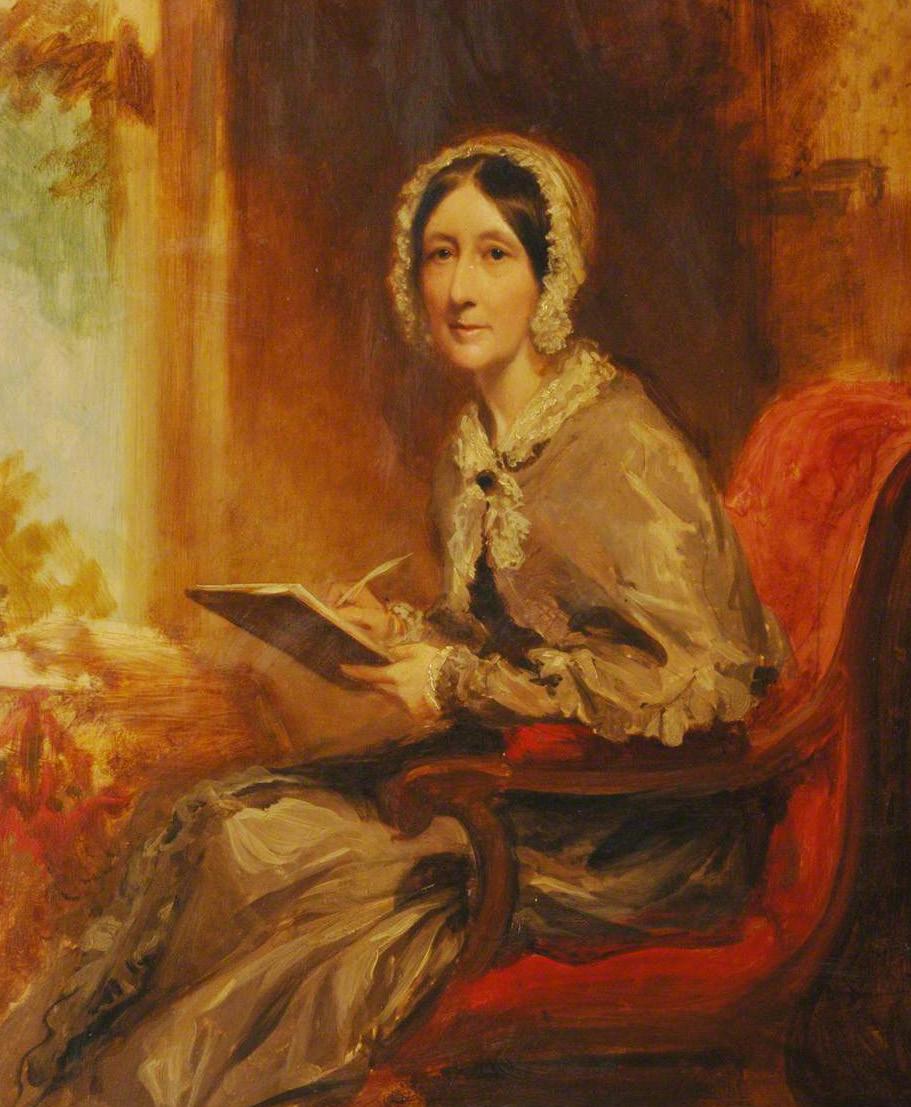
As Somerville’s children had no children of their own, responsibility for her papers passed to the Fairfax-Lucys, the descendants of Somerville’s brother. In 1965, after being stewarded by the Fairfax-Lucy family for nearly a century, a significant collection of items was deposited at the Bodleian Library on behalf of Somerville College, with a further deposit made in 1972. As can be seen in the Mary Somerville room, College has collected more than just written materials, holding numerous oil landscape paintings produced by Somerville and a cabinet full of shells.
Such a varied and immersive archive for a single person is a rare occurrence, and even more so for a scientific woman. Far more often, women appear in the archival collections of more-celebrated male relatives or collaborators. They are background characters rather than protagonists, emerging and disappearing with little fanfare, obscured by a married name – such as “Mrs John Smith” – or
not named at all. Historical women are disadvantaged two-fold when it comes to their work in the sciences being documented. Not only are they less visible in personal papers, but they were predominantly excluded from formal scientific institutions and societies until well into the twentieth century. Their names are much sparser in publications, membership lists, or as winners of prestigious prizes. These limitations on archival sources continue to impact our understanding of the roles taken by women in the historical development of science and mathematics.
Hence the Mary Somerville Collection is an exciting and valuable resource for studying the history of science. Beyond illuminating the work done by Somerville herself, these papers demonstrate the vital role played by mixed-gender polite society – at private dinners and public balls – for the circulation of new ideas. It was in these spaces that Somerville accessed mathematical and scientific knowledge and forged a reputation for herself as an expert that she later relied on in her career as a scientific author. By transcribing items from this collection, they will become much more visible and accessible to researchers and showcase the many areas of historical inquiry on which Somerville’s letters touch. This is especially important for her mathematical work, most of which remained unpublished both in her lifetime and since.
This collection of letters presents a selection of previously unpublished correspondence between Mary Somerville and some of her closest friends, colleagues and scientific acquaintances. Several of these letters derive from the Mary Somerville Collection held at Somerville College. Others were selected for inclusion by Dr Brigitte Stenhouse for their capacity to shed further light on Somerville’s life and work, including letters written to the mathematician Ada Lovelace, publisher John Murray, and astronomer and chemist John Herschel.
The letters were transcribed as part of a ‘Mary Somerville Transcribe-a-Thon’ held at Somerville College in November 2022. This event was conceived as a means of commemorating 150 years since the death of Mary Somerville, the extraordinary scientist who gave Somerville its name and deep regard for the pursuit of knowledge. We are deeply grateful to the many members of the Somerville community, including our students, staff and academics, who gave their time so generously to transcribe one or more of these letters. A full list of contributors can be found in the acknowledgements page.
We wish to express our thanks to everyone who supported this project, including the custodians of the letters, the National Library of Scotland, the Bodleian Library and The Royal Society. We also wish to thank the copyright holders who kindly granted permission to reproduce them and our transcribers for donating their skills and time so generously. Finally, we wish to express a special debt of thanks to Dr Stenhouse for the many hours spent in selecting these letters, and reviewing and checking the transcriptions. Together these many contributions have enabled us to make this small yet valuable addition to the scholarship of Mary Somerville.
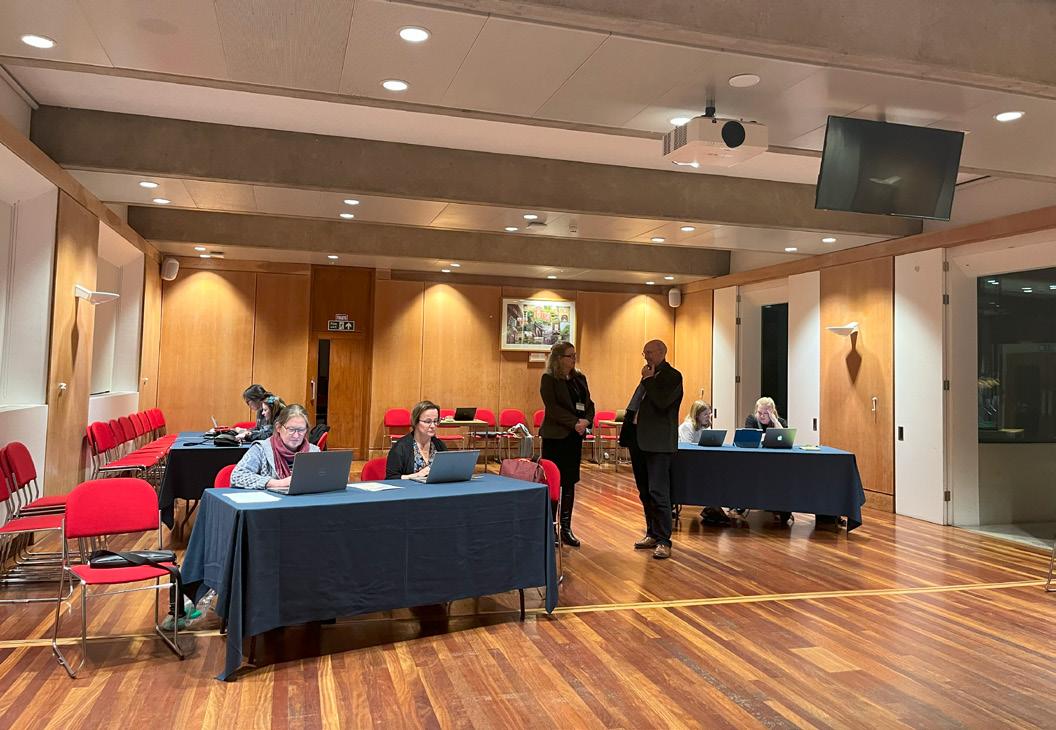

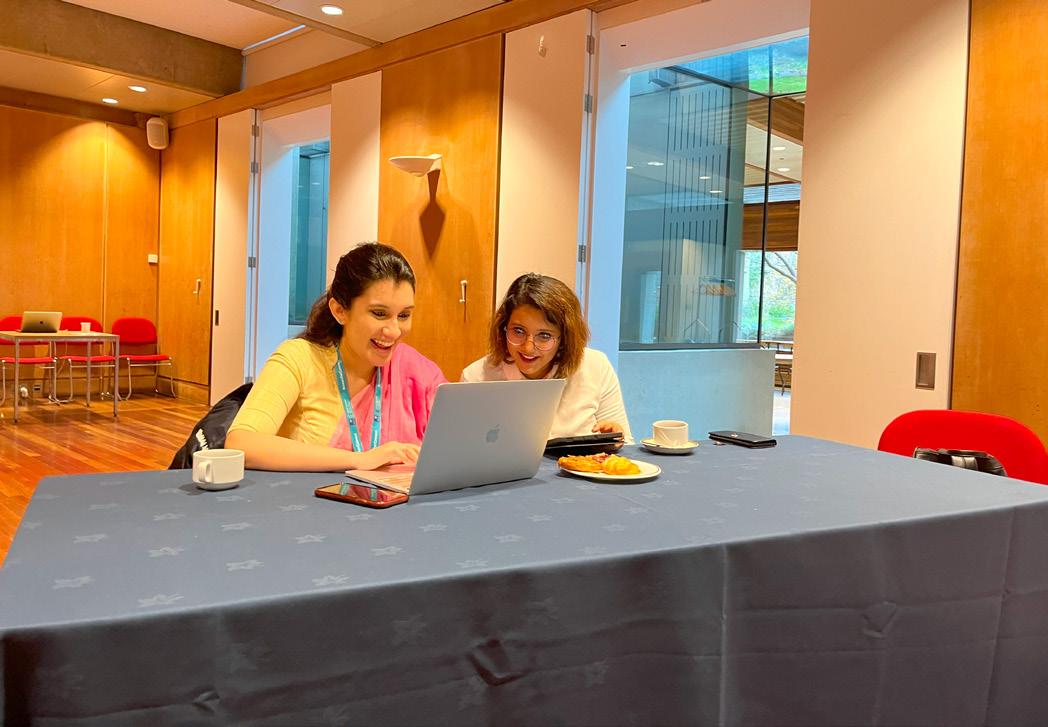

23rd February 1832
Author: Mary Somerville
Recipient: Sir John William Lubbock
Royal Society of London, JWL/S/292
My dear sir,
I beg you will accept of my best thanks for your excellent and valuable papers. I have the greatest pleasure in congratulating you on the power and elegance you have shown in the whole analysis of your LunarTheory, and the facility the formulae afford the calculations [.] You must have much satisfaction in having done so much for the Science of your Country.
I really hope when we meet that you will have the kindness to decipher the Baron Poisson’s most unintelligible writing, it is quite tantalizing to had[sic] such letters in my possession without being able to profit by their contents. I should have returned them to you before had I not intended calling on Lady Lubbock and have unfortunately been prevented.
Yours very sincerely
Mary Somerville 23d Feby“ You must have much satisfaction in having done so much for the Science of your Country.”
28th July 1835
Author: Mary Somerville
Recipient: Ada Byron (Lovelace)
National Library of Scotland, MS 41131, 85-86
[Postal mark: ? Noon 10 MR 2 1835]
The Honble Miss Byron
Fordhook
Acton
My dear Miss Byron,
There is not the least reason for dismay, I can assure you I only concluded that it was not in your power to come to us this week, but I trust we shall be more fortunate during the next. I have no engagement except on Monday, and shall be delighted to see you any other morning that Lady Byron can spare the carriage. I hope you still find pleasure and improve-ment from the lectures. The second edition of my book is already sold, to the number of 3000, so I must begin to propose a third. I think myself very fortunate. With every kind wish believe me most truly yours
Mary Somerville
R.H. Chelsea
Saturday 28th July
“The second edition of my book is already sold, to the number of 3000, so I must begin to propose a third.”
Recipient: John Murray III
National Library of Scotland, MS 41131, 150-151
Spezia 28th Octr 1866
My dear Mr Murray
I am greatly pleased to find that you are willing to publish my MS. I should have been truely[sic] grieved if you could not have undertaken it. You give me courage to appear before the public in my old age. It is 35 years since your Father published the Mechanism of the Heavens, and I hope to live to see you bring out my last work
I have reduced the number of wood cuts considerably, and I have written to Dr Carpenter requesting permission to have casts taken from his wood cuts and copies from his plates. I have every reason to hope that he will grant my request as he has already given me leave to make any use I please of his drawings. I think I may rely on the friendship of Professor Owen & I have the same reason to believe that the brother of the botanist Henfrey now dead will give me leave to have casts from the wood cuts which he made himself. They would superceed[sic] all those of Mrs Gatty and ____
As soon as I receive answers I will let you know the result. I have no acquaintance with the Rev ____ Mr Darwin, or Mr Gosse, all very essential but I trust that through the kindness of my dear daughter Mrs Greig that means may be found of applying to them as I fear it would be too bold a measure were I to write to them myself.
I beg you will remember me kindly to Mrs Murray who I hope is well and the children thriving, I shall hear all about your from Mr Pentland who has promised us a visit while on his way to Rome.
Yours my dear Mr Murray
very sincerely
Mary Somerville1866 Octs 25
Somerville Mrs
“I am greatly pleased to find that you are willing to publish my MS”
4th of March 1870
Author: Mary SomervilleRecipient: John Murray III
National Library of Scotland, MS 41131, 197-198
Naples [deletion: 4]th [written above: 5th] [but 5 has been overwritten with 8] March 1870
I am very much pleased with the new edition of my Phys. Geo. and I should have written to thank the gentleman who has done it so well if I had his name and address, but if you will send them it may not be too late yet. The wonderful discoveries of Mr Tyndall in molecular science have induced me to prepare for a second edition of my last book, though it may never be needed it has given me occupation & will be left in the hands of my daughters together with my autobiography at my death.
Mr & Mrs Sopwith arrived on the 3d after a very rapid journey and gave me a good account of you and yours. I was truly glad to see my old friend after so many years. I thank you for the book you sent by him, my name being in it puts me in mind to tell you that I have been elected a member of the American Philosophical Society of Philadelphia. I know nothing of Pentland’s motions but I think we shall probably see him before he starts for England
With kind remembrance to your Ladies believe me to be yours very sincerely
Mary SomervilleThrough the kindness of Mr Spottiswode[sic] the members of the Royal Institution voted that I was to have a copy of their procedings[sic] [deletion: transaction] as they come out, now I have not recieved [sic] any for several months & feel a delicacy about asking for them, besides I do not know how often they are published. Will you kindly manage this for me; The last I recieved[sic] was the dated July 1869.
1870 – Mar 4
Somerville – Mrs
“The wonderful discoveries of Mr Tyndall in molecular science have induced me to prepare for a second edition of my last book...”
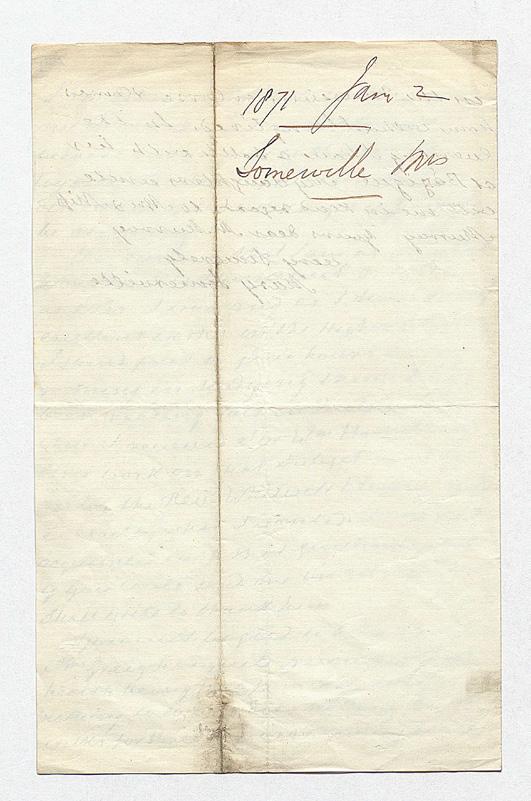 Author: Mary Somerville
Author: Mary Somerville
Recipient: John Murray III
National Library of Scotland, MS 41131, 203-204
Dear Mr Murray
I have been long of writing to you but I had good accounts of you and yours from Mr Pentland I thank you for the Quarterly, it contains many excellent articles but you may believe that as Sir Henry Hollands reminiscences is the most interesting to me. He certainly is a man of great energy & talent He moved among the [?] & powers, my life was very different but there are numerous anecdotes similar to those in my autobiog[raphy] but not identical, for I never copy from any one. I always find something to add to my life so it will be a large Volume I am surprised that Sir Henry was not in attendance on the Prince [?] were it not for the enthusiastic loyalty excited by his illness the discontent of the working class would be alarming
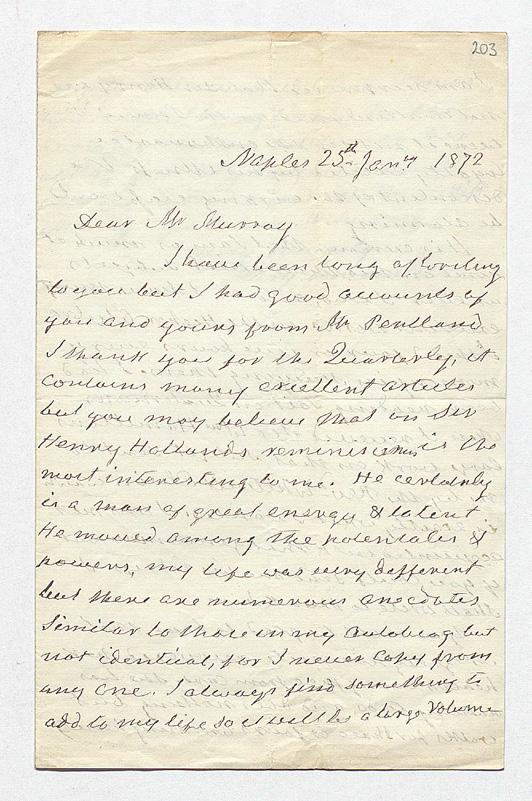
It is curious that I am as much at home on mathematical subjects as ever I was, and as I have [plenty?] excellent works on the Higher Algebra. I spend four or five hours every morning in studying them. I had been reading Tait on Quaternions when I received Sir Wm Hamiltons large work on that subject sent to me by the Revd Whitwell Elwin which is exactly what I wanted. I am not acquainted with that gentleman but if you could send me his address I shall write to thank him
You will be glad to hear that Mrs Greig has quite recovered her health being free from care, she has nothing to do, and does nothing but walks for three or fours amusing herself. In the museum or Corso & Comes home without being tired. In the evening I have a bottle with her as [?] My daughters write with me in kind regards to Mrs & Miss Murray yours dear Mr Murray
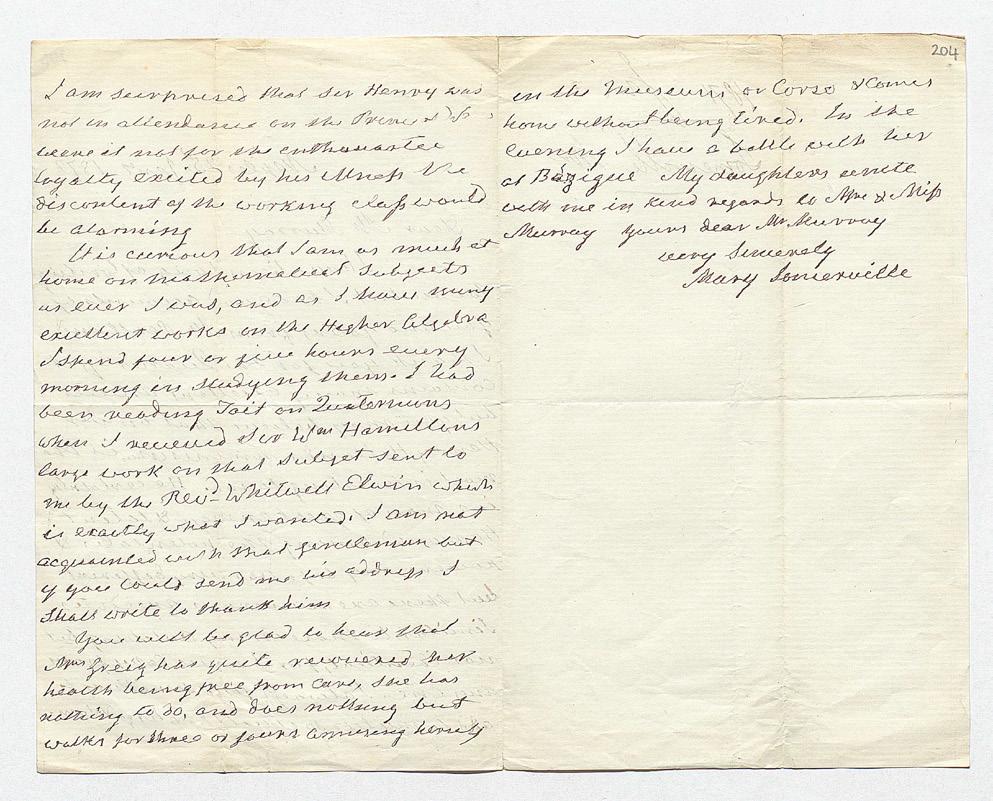
Very Sincerely
Mary Somerville1871 fam 2
Somerville Mrs
“It is curious that I am as much at home on mathematical subjects as ever I was...”
November 1872
Author: Mary SomervilleNaples Novr 1872
Dear Mr Murray
I thank you sincerely for your Kindness in Sending me a copy of Darwins new book which interests and amuses me exceedingly the more so as I have always had and still have many animals chiefly dogs and birds so that I am well acquainted with [insertion: their] characters & expressions. He still maintains his evolution theory which is not gratifying to our vanity.
I regret exceedingly that I did not see Mr Forsythe both as a friend and schoolfellow of yours and of my dear Woronzows. When his card was sent to me at Sorrento he had already left Naples. I was sorry to hear that Mr orsythe was ill at Rome but I hope they are safely arrived in London. We are now resuming our usual habits at
Vδθ... SδβΓγ2Sαβ - SβγSγα
Vβγ – SβγSαβ(α2Sβγ γ Sαβ
Vαβ = - Sαβ
Vαβγ = αSβγ – βSγα + γSαβ which gives
To this γ & α may be changed Vαβγ = Vγβα Naples. I still solve problems by the higher algebra or add to the narrative of my life in the morning and though [weak?] drive out [occasionally?]
“I still solve problems by the higher algebra or add to the narrative of my life in the morning”
[undated]
Author: Mary Somerville
Recipient: [none - page from a workbook]
Bodleian Library, Dep. c. 352 MSSW-5
Determine that point in a curve whose equation is �������� �������� = ���������������� 1 �������� , to which a line must be drawn from the vertex making the greatest angle with the curve.


Let ������������������������ be the curve, �������� the vertex, ���������������� , ���������������� being the co-ordinates whose origin is in ��������
From [deletion: the] any point in the curve as �������� , draw the tangent ���������������� to meet the axis produced in �������� . join ���������������� . The angle ������������������������ must be a maximum.
Make the angle
By substituting these in the expression for the tangent of
it becomes
the equation of the
If �������� = 2 then �������� 2 = ���������������� the equation of the common parabola. In this case �������� = �������� 4 �������� =
2 , �������� being the parameter So the point required is that in which the parameter meets the curve. M.S.
[Deletion: C]
[Deletion: B]
���������������� , ���������������� are the subtangent and ordinate of a curve whose vertex is in �������� , and the tangent of the angle ������������������������ is to the tangent of the angle ������������������������ in a given ratio, what is the value of the curve? Let ���������������� = �������� , ���������������� = ��������
The tangent of ������������������������ is ������������������������ ������������������������ ������������������������+������������������������ and Tan ������������������������ = �������� �������� but these must be in a given ratio of 1 to �������� hence
“Determine that point in a curve whose equation is y n = an-1x...”
, ���������������� are the subtangent and ordinate of a curve whose vertex is in �������� , and the tangent of the angle ������������������������ is to the tangent of the angle ������������������������ in a given ratio, what is the value of the curve? Let ���������������� = �������� , ���������������� = ��������
are the subtangent and ordinate of a curve whose vertex is in �������� , and the tangent of the angle ������������������������ is to the tangent of the angle
The tangent of ������������������������ is ������������������������ ������������������������
in a given ratio, what is the value of the curve? Let ���������������� =

and Tan ������������������������ = �������� �������� but these must be in a given ratio of 1 to �������� hence
The tangent of
but these must be in a given ratio of 1 to �������� hence
In order to find the integral put �������� =
In order to find the integral put
, then ���������������� = ������������������������ + ������������������������ , substituting these and dividing by ��������
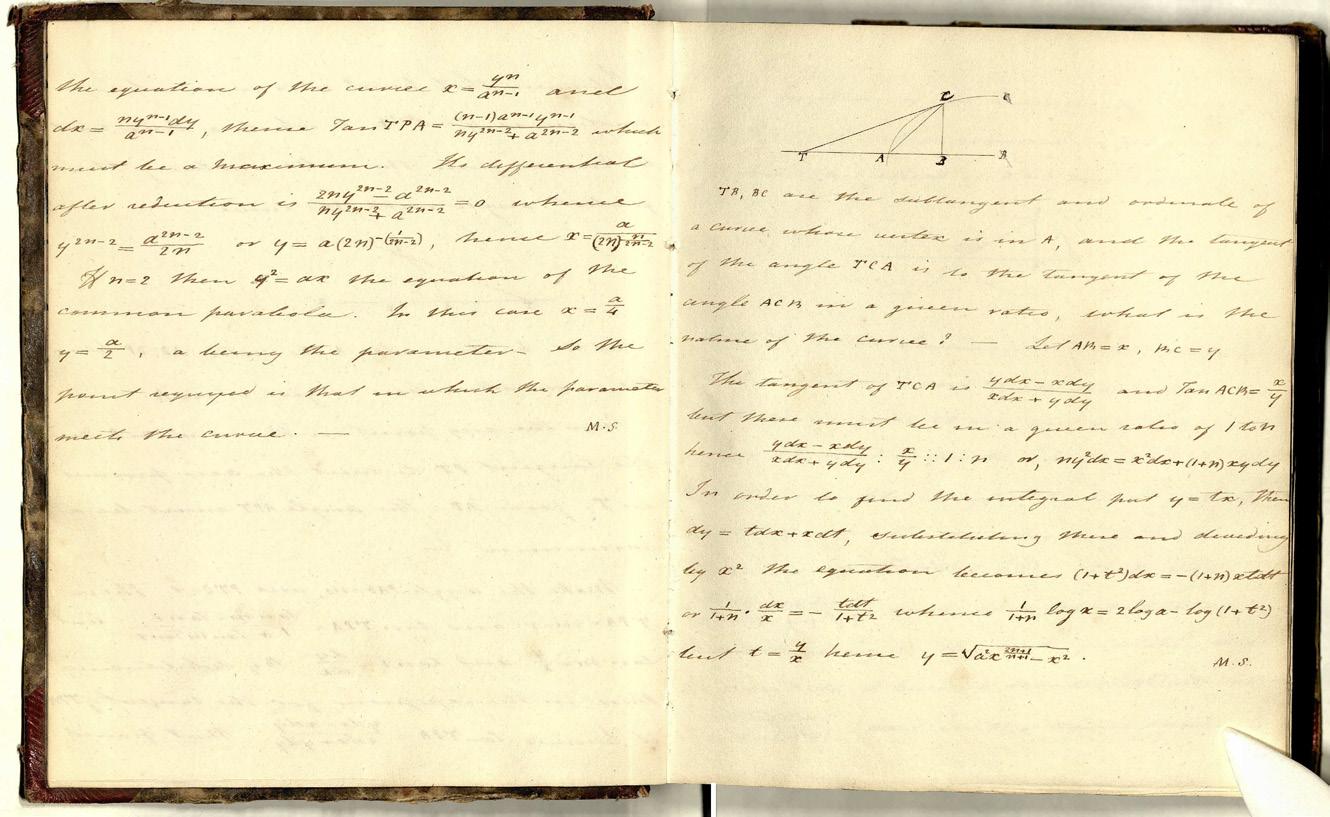
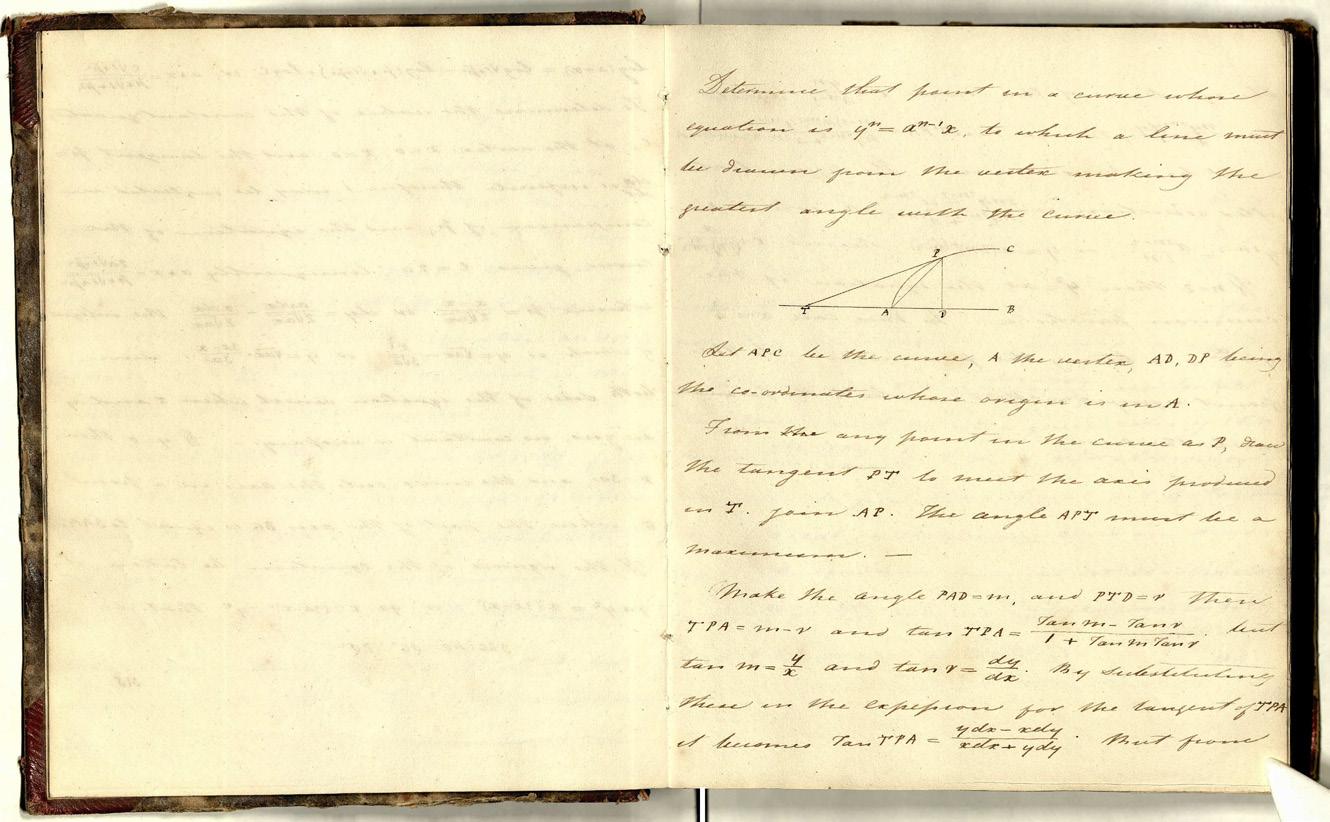
, then
, substituting these and dividing by ��������
the equation becomes
the equation becomes (1
24th November 1872
Author: Mary Somerville
Recipient: None; these are solutions to questions posed in Peter Guthrie Tait’s
An Elementary Treatise on Quaternions
Bodleian Library, Dep. c. 351 MSSW-1 pp.37-39
Examples to Chap. 2d
Example 1st
To show that that the product of 2 Versors represented by two angles of a spherical triangle is a third Versor represented by the supplement of the remaining angle of the triangle and determine the Rule by which the angles are to be measured.
Let ABC = i, ACB = j and CAB = k i j k being unit vectors, when employed as factors they may be considered to be quadrantal versors
Let ABC ACB be right angles, then the supplement of the angle BAC is π - BAC or π - k the third versor. By right handed rotation (65) i unites with j, and when ij revolves then ij unites with k thus ij k When j rotates it coincides with k, and when jk revolves it unites with i, so jk⋅i lastly when k revolves we have ki⋅j thus by right handed rotation the result is ij k, ik j, jk i
we cannot have ij = ji without reversing the rotations whence it appears that
Example 2
the Equation pq=qp is not always true
To show that the associative system may be made to depend upon the fact, that if from any point of a sphere tangent arcs be drawn to a spherical conic, and also arcs to the foci, he inclination of either tangent arc to one of the focal arcs is equal to that of the other tangent arc to the other focal arc
The figure represents half of a sphere and ab, b1[?] the half of a spherical conic inscribed within it, the centre of the conic coinsiding[sic] with the centre of the sphere
Let the tangent arcs βa βa1, drawn from b, a point in the sphere be represented by p p1, the tangent arcs βb βb1 by q q1 and the focal arcs βc βc1 by r the p, q, r, p1 q1 r1 being versors; when by right handed rotation βa coincides with βb, then nb[?]= pq and when βb revolves till it coincides with βc then pq⋅r.
On the other side of the conic still by right handed rotations, when bb1 revolves till it coincides with βa1 then βa1 is equal to qp, and when βa1 revolves with βc1 then qp⋅r but the arcs are respectively equal two and two and these inclinations are equal, hence pq⋅r=qp⋅r Hence pq=qr
Prove that 2Sαβγ=αβγ- γβα
and 2Vαβγ= αβγ+ γβα
By (3 & 4 86) αβ+βα= 2Sαβ and αβ-βα=2Vαβ
By (88) βγ may be put for β then αβγ+βγα= 2Sαβγ
and αβγ-βγα= 2Vαβγ
So 2Sαβγ=αβγ-γβα and
“it appears that the Equation pq=qp is not always true’”
Hence pq=qr
Example 4
Prove that 2Sαβγ=αβγ- γβα
and 2Vαβγ= αβγ+ γβα
By (3 & 4 86) αβ+βα= 2Sαβ and αβ-βα=2Vαβ
By (88) βγ may be put for β then αβγ+βγα= 2Sαβγ and αβγ-βγα= 2Vαβγ
So 2Sαβγ=αβγ-γβα and 2Vαβγ=αβγ+ γβα
Example 5
By (88) γδ may be substituted for γ in the Equation Vαβγ =Vγβα which then becomes Vαβγδ =Vδγβα again putting δε for δ we have Vαβγδε =Vεδγβα and so on, whatever the numbers of vectors there may be.
Example 6
B[y] (3 & 4,86) αβ=Vαβ+Sαβ and 0=Vαβ+Sαβ so
Vαβ=-Sαβ but Sαβ=Sβα hence
Vαβ = - Sβα, VαβVβγ=-SβγSβα=-Sβ 2 γα
VαβVβγVγα=-SγαSβ2 γα=-Sβ
S⋅VαβVβγVγα=-SS α
VαβVβγVγα=- S α
β
β
γ2=-(Sαβγ)2 Now
β
V⋅VαβVβγVγα=Sαβ (γ2 Sαβ-SβγSγα) again
VαβVβγ=Sαγβ2=Sαβγ(bSαγ-αSβγ) so
V⋅{VαβV⋅VαβVβγVγα}=Sαβγ{βSαγ-αS[?]γ}
Example 7
By (182, 86) Vαβ=-Sαβ. Now α, β, γ being vectors at right angles to one another by (74) Vαβ is a Versor and by right hand rotation is = γVαβ so γVαβ = -Sαβ
γ2 Vαβ = γ Sαβ
γ3 Vαβ = γ2 Sαβ &
γ4 Vαβ = γ3 Sαβ=α or = αVβγ
By the very same rotation we obtain α4Vβγ=α3S[?]β
β4Vγα =β3S αβ so
α4Vβγ+β4Vγa+ γ4 Vaβ=(a3+β3+ γ3)Sαβ
But by (88) βγ may be put for β in the scalar so
α4Vβγ+β4Vγα+ γ4 Vαβ=(α3+ β3 + γ3)Sαβγ
24th Novr 1872
16th of September 1844
Author: Mary Somerville
Recipient: John Herschel
Royal Society of London, HS/16/350
How can I sufficiently thank you my dear Sir John for your exceeding great Kindness, for the time you have spent, and the pains you have taken to gratify me in matters which though of high interest to me are not likely to be of any use. To you also I am indebted for the readiness with which both Mr. de Morgan and Mr. Talbot have sent me their papers, so that I have now got photographic apparatus and books sufficient to keep me busy for a very long time and to you I owe that pleasure. I think the fatigue of all my long journey from Italy was worth undergoing for the pleasure of the few days I spent with Lady Herschel and you, and one of the brightest prospects during our residence abroad will be to return to good society and friendship, and I feel deeply the privilege of being connected with you by the sacred bond of my dear little God child in whose good behaviour and good health I take all the interest I ought to do. You say nothing of Lady Herschel’s health so I hope she soon recovered from the fatigue we [?] her perhaps a little too soon after her confinement. My Son and Miss Greig were charmed with their visit to Collingwood and desire me to say every thing that is kind to Lady Herschel and you, they accompany me to Folkstone today and tomorrow to Bologne whence I take leave of them and proceed on my journey. With every wish for health & happiness to you and yours be assured that I ever am your obliged & affectionate friend
Mary SomervilleLondon
16th Septr.
“...I have now photographic apparatus and books sufficient to keep me busy for a very long time and to you I owe that pleasure. ”
Trinity Coll: Tuesday Mar.3
Your letter delighted me & I am sure you have decided wisely not to rusticate at the Observatory. The time you have fixed is the best of all possible times and I hope you will write as soon as possible to finally fix the hour of your arrival – I have a plan in my eye which I think quite excellent. Mr. Sheepshanks’ rooms, on my staircase, are now empty and I believe he does not return into resi-dence next week. In that case we will [?] a regular matrimonial four poster bed & try to domesticate you and Mrs. Somerville within the college walls. This experiment was tried and approved of by Mr & Mrs. Murchison; the rooms in question [page break] are very good; have a dressing room with a fireplace attached to them, & a small mathematical library in which Mrs. S. may disport herself when she is tired of duller subjects. The day you arrive, I can either give you a quiet dinner or ask a few friends to meet you. I mention the alternative because Mrs. Somerville may perhaps anticipate fatigue & not wish to meet a party the first evening. Only express your wishes on this matter & they shall be law. - I shall write by this post to Sheepshanks and if by any mischance I should be disappointed in my present plan, I will secure rooms for you opposite Trin:Coll: - Give my kindest greetings to Mrs. Somerville & your family & believe me, Most truly yours
A. Sedgwick
PS If any[?] other lady cares[?] of your party she might be excellently accommodated with a small bed room on the same floor; opening in the dressing room of wh[ich]. I spoke.
The Revd A. Sedgwick
Trin. Col. Cambridge
March 1832
Dr. Somerville Chelsea College
London
“...& a small mathematical library in which Mrs. S. may disport herself when she is tired of duller subjects”
March 1832
Author: The Reverend Adam Sedgewick
de Genève
26th of April 1833
Author: Jane Marcet
Recipient: Mary Somerville
Bodleian Library Dep C.371 MSM-2 fol. 176
Mr s Somerville Chelsea College Dear Mr s SomervilleCalling on my Sister Prévost this morning, I saw on her table a parcel destined for you from the Profeseur[sic]. I seize the opportunity of begging you to direct me how I am to dispose of a Copy of your work directed to you at Malagny, with a request that I should open it if you were departed. I found from a letter inclosed[sic] that the Vol. was brought as far as Berne [page break] by Mr Murray junr at Dr Somervilles request, thinking you might wish to present it to some learned society. If you should be disposed to give it to the Soct. de Physique et d’histoire Naturel de Genève Prof s Prévost says they will know how to appreciate it; & it will be by them transmitted to the Bibliothèque de Genève.
En attendant I have lent it to the Prof s Prévost, who is delighted with it; but pray do not be influenced by what I have written, but let me know without compliments or resonne[sic] what I should do with the book.
I regretted not to have met you on your return, but we were then absent on our tour, which stretched out as far as Milan, over the Splugen[sic] & back by the Simplon. I write this in great haste; Louisa has had the scarlet fever but so mildly that she has not been ill, & the disease was detected only by the rash.
With kindest remembrance to the young Ladies & Dr Somerville believe me ever truly Yours
J Marcet“If you should be disposed to give it to the Soct. de Physique et d’histoire
Naturel
Prof s Prévost says they will know how to appreciate it...”
2nd of February 1835
Author: Henry Ingersoll Bowditch
Recipient: Mary Somerville
Bodleian Library, Dep. c.389 MSB-12 fol. 374
Mrs Somerville
To the care of Dr Somerville
Surgeon of the Royal Chelsea Hosp.
Chelsea
Feb 24th 1835
Mrs Somerville
Dear Madame
Among the many notes I took of circumstances to be remembered by me on my arrival in America, was one in reference to a remark that fell from your husband, while I was with him at Chelsea. He spoke of your study of crystalization[sic], & hinted that you would like to have a specimen of green Feldspar, in a crystallised slate as found in Massachusetts. I am sorry I have so poorly succeeded, in obtaining what you want, but in the bundle which accompanies this letter you will find all the specimens, Dr. Webster, Professor of Mineralogy could obtain for me. This gentleman is the one who [?] obtained my good specimen of the crystal, and he in-forms me that it is very rare; that he knows of but one perfect one, which is now at the cabinet of Cambridge University. With the Feldspar you will find some other crystals which may interest you. but I send you also two pamphlets one, containing an article, treating of a peculiar mineral found in Sterling Mass. and of which you will find specimens in the bundle. the other, containing a sermon on War by Dr. Channing [probably William Ellery Channing] The former was written by one of our best naturalists Dr. Jackson, and possibly may be entertaining to you -; the other I know you will peruse with pleasure, as I remember, you told me you had a high opinion of Dr C’s [?]. The sermon was delivered a few weeks since the occasion of it being the threatening aspects of our affairs in relation to France; and the message of our President; Miss Martineau has quite excited the good people at Wash-ington, and is, we hear, always attended by some one of the great men of the land. One [?] of a Boston Editor writes that “Miss M. was in the Senate Chamber today, and Mr Clay was at her side, pouring words of wisdom into her ear; and pepper-mint-lozenges into her hand.”! She is quite the belle of Washington, this season - . We hope ere long to see her at Boston, which she has not yet visited.
My Father is very well – and has commenced his fourth volume and I am engaged in preparing the fifth for his examination. He desires me to present his sincere thanks to you and Dr. S. for your kindness to me when in Europe - . We often talk together of London friends, for he feels as if he were personally acquainted with you all – In truth I hope to introduce him to you at some time although he always shakes his head, [?] his grey locks, when I speak of his going, before many years have elapsed, to visit Europe. With sentiments of deep gratitude & respect I remain – your humble servant
H. I. Bowditch“With the Feldspar you will find some other crystals which may interest you.”
1st of March 1836
Author: Francis Baily
Recipient: Mary Somerville
Bodleian Library, Dep. c. 369 MSB-4 fol. 298
My dear Mrs Somerville
I was extremely sorry to find, on my return home last night, that Dr. Somerville had called during my absence from home. It was my intention to have paid you a visit on Sunday, but I was unavoidably pre-vented: & as I knew that other persons would be interested in Herschel’s account of his Meteoric observations in November last, I thought it best to send a statement to the Editor of the Athenaeum, which in fact comprises all I have received on the subject, and to which I must refer you. It is inserted in the paper of last Saturday.
Herschel has also sent me some drawings of the appearance of Halley’s comet in October last, which are now in the course of being copied, to be sent to Bessel who is drawing up a paper on the physical constitution (for so I understand it) of this remarkable & interesting body. In a late number of the Astron[omische]: Nach[richten]: (No 298) there are [insertion: several] some drawings of the appearance of the comet by M. Schwabe, which agree with & confirm the general appearance of that by Mr. [Casper?]. Herschel proposes the return to Europe by the way of Rio Janeiro; & wishes to know whether there is any thing at that place, wherein he can be of any service to science. He does not, however, allude to the period of his return.
I am now engaged in drawing up a little history of the state of the lunar theory immediately preceding the first edition of the Principia: whereby I think it will be seen that Flamsteed was by no means ignorant of what Newton was about, as far as regards the moon: and that they went hand in hand, in their efforts to improve the lunar tables. I may perhaps print it at some future time: but certainly not, till the present excitement is a little abated, as we seldom can get these subjects fairly discussed till the heat of contention is over.-
Believe me, with the highest respect, yours most truly and sincerely
Francis BailyMrs
Somerville“Herschel has also sent me some drawings of the appearance of Halley’s comet...”
Recipient: Mary Somerville
Bodleian Library, Dep. c.371 MSP-1 fol. 235
I had sent orange marmalade for the arctic voyage, M.S.
My Dear Mrs. Somerville,
I received your kind and truly valuable present quite safely yesterday, and beg you will accept very best thanks for your very liberal contribution to my stock of comforts on the ensuing voyage. Your present is, indeed, on so large a scale that I am hesitating whether I shall not have to apply for a little ferry to accompany me, for the purpose of carrying all these good things.
May I, in return, beg your acceptance of something much less tempting — a few specimens of the production of Melville Island &c. Any which are not marked are from Winter Harbour or its neighbourhood. I have added a few plants, as I yesterday heard that Dr. S. was desirous of seeing some. I heartily wish they were all better worth your acceptance.
I am very dear Mrs. Somerville
Very sincerely yours, Mr W Parry
3 Downing
Sunday
“Your present is, indeed, on so large a scale that I am hesitating whether I shall not have to apply for a little ferry... for the purpose of carrying all these good things.”
An English astronomer, and one of the founders of the Royal Astronomical Society (of which he would become President on four separate occasions between 1825 and his death). In 1835, Mary Somerville and Caroline Herschel became the first female (honorary) members. He is best known as the namesake of ‘Baily’s Beads’, the phenomenon wherein the topography of the moon allowing the sun to shine through in some places and not others in an eclipse gives the illusion of beads of light.
An American physician and passionate abolitionist, he was a mourner at the funeral of William Wilberforce and was a leader of the public campaign to save escaped enslaved person George Latimer from deportation back to Virginia in 1842. His medical legacy includes helping to popularize the stethoscope, serving as president of the American Medical Association, and founding the Massuchetts State Board of Health. He was hosted by the Somervilles in 1834, and sent four letters to Mary Somerville thereafter.
Known commonly as Ada Lovelace, she is hailed as one of the founders of computer science. As a girl she was tutored in maths and science by Mary Somerville. Somerville was responsible for introducing Lovelace to Charles Babbage in 1833, whose analytical engine would inspire Lovelace’s groundbreaking research. As she reached adulthood, Somerville became more of a mentor and role model on everything from physics to motherhood. Ada Lovelace was the only daughter of poet, satirist and raconteur Lord Byron.
An astronomer, mathematician, barrister, banker and the first Vice-Chancellor of the University of London, he was one of the foremost intellectuals of his era. After graduating from Cambridge in 1825, he was elected a Fellow of the Royal Astronomical Society in 1828 and, in 1829, a Fellow of the Royal Society. The latter brought him into contact with William Somerville, who became a frequent correspondence partner. Lubbock shared his research and elements of his archive with Mary Somerville, including some of the papers of the late Baron Simeon Denis Poisson (whose handwriting was evidently difficult to read).
An author and socialite, like Mary Somerville she was a polymath whose expertise spanned economics, biology, maths, geology and more. Her writing on chemistry was particularly successful: her 1805 work Conversations on Chemistry, Intended More Especially for the Female Sex (published anonymously until 1832) was one of the first elementary science textbooks and an important moment in the development of public female intellectual culture. It ran to 16 editions and inspired the young Michael Faraday, among others. In 1816, Mary Somerville moved to London and at once sought Marcet out, who became a mentor, role model, and friend.
The third generation of John Murrays to helm the John Murray publishing company, John Murray and his father John Murray II were Mary Somerville’s publishers for her distinguished literary career. Somerville sent over 100 letters to the two over her life, many of which are preserved in the John Murray Archive. The Murrays also published many other groundbreaking intellectual texts, including Charles Darwin’s On the Origin of Species
A navy officer and arctic explorer, William Parry in 1820 became the first person to navigate the Parry Channel that links Baffin Bay and the Beaufort Sea. He also had a keen interest in astronomy. Parry brought Somerville seeds and minerals from the Arctic. Mary Somerville made contact through her husband William; both men were members of the Royal Society.
An important figure in the development of geology who was the first to propose the Cambrian and Devonian periods, Sedgewick was also an Anglican priest. Somerville may have met him through their shared social circles, or she may have been connected with him by her husband Dr Somerville, as both men were members of the Royal Society. Despite his respect for Mary Somerville’s dedication to mathematics, Sedgwick was also a staunch and vocal opponent of women’s university education in the UK.
Mary Somerville’s first husband Lieutenant Greig was not a great supporter of education for women. By contrast, Dr William Somerville used his connections and resources to provide his wife with access to books, learned academies, and publication opportunities. A descendant of a cadet branch of the noble Somerville family, William served as an army surgeon in South Africa, followed by a successful career as a hospital inspector. He married his first cousin Mary Somerville in 1812. Elections to the Royal Society of Edinburgh in 1813 and the Royal Society and the Royal College of Physicians in 1817 gave both Somervilles access to the elite intellectual circles of their day, and he was able to make introductions for Mary to important correspondents and collaborators.
© Somerville College 2023
Registered Charity no. 1139440
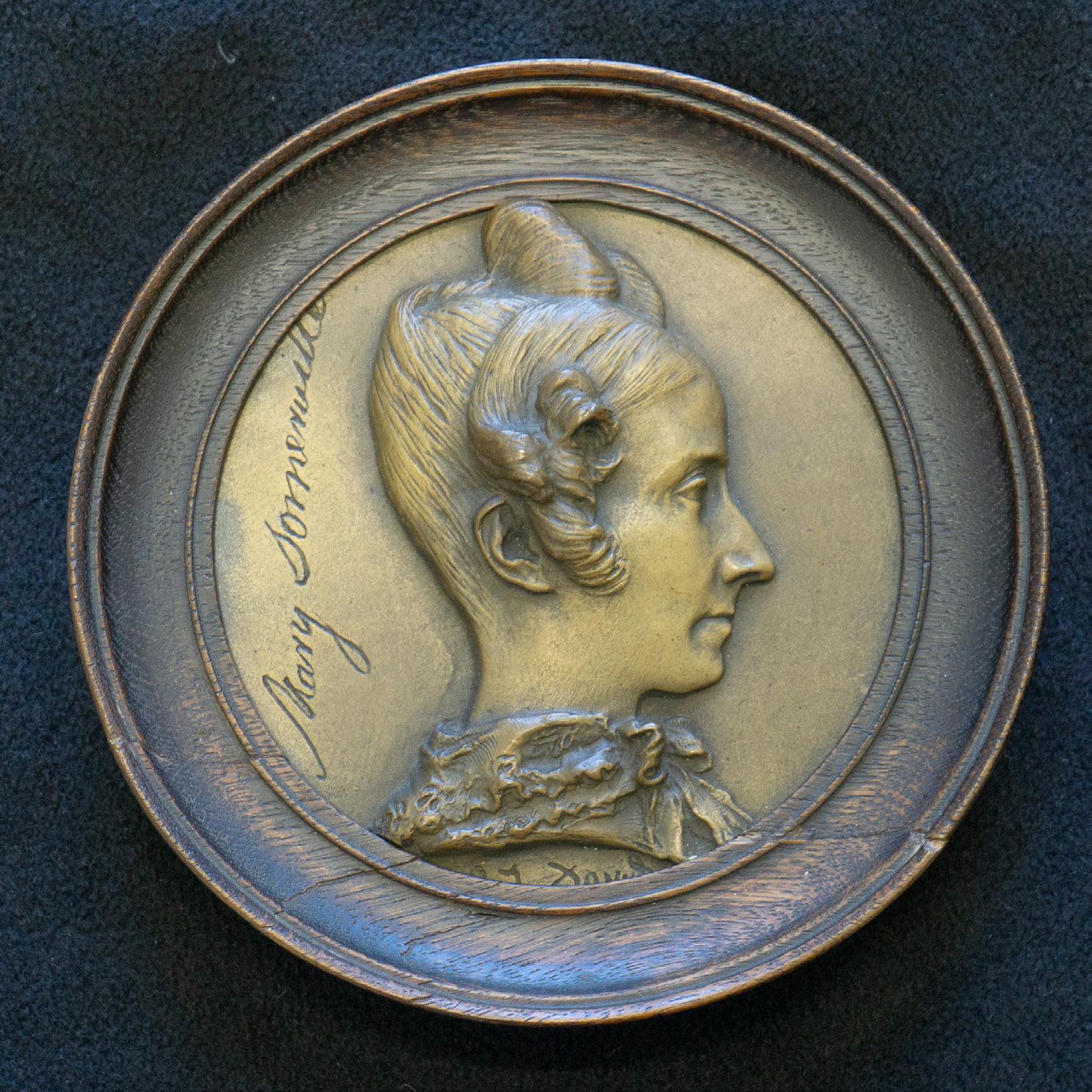 Bronze Portrait Medallion, Pierre-Jean David D'Angers, 1833
Bronze Portrait Medallion, Pierre-Jean David D'Angers, 1833